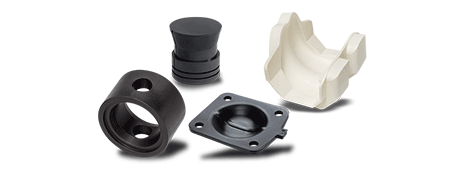Depending on the raw material supplier, the number of elastomers ranges from around two dozen right up to several hundred. This has to do with the fact that the material "rubber" is prepared with other substances. The basic polymer, for example NBR or EPDM (see below), is mixed with fillers, crosslinking agents and other additives. While crosslinking agents such as peroxides or sulphur are important for the elastic properties and resilience, fillers provide the strength and mechanical properties of the elastomers. Mixing the materials creates a number of compounds which are ideally suited to moulded parts.
Selection according to medium and parameters
If you would like to select a material from this selection, and in particular a specific compound, please include all relevant chemical and physical properties of your process.
Example: Contact with liquids, gases and steam
- Medium (inert, corrosive, explosive, contaminated, particulate, abrasive, viscous, conductive, statically charged, etc.)
- Media temperature and ambient temperature
- Operating pressure and pressure rating (if available)
- Aggregate state
- Volumetric flow, etc. (if available)
Auxiliary processes, such as cleaning cycles and sterilisation and disinfection processes, should also be included. Particularly when there are high concentrations of corrosive and/or abrasive media and where materials are being used for the first time, we would advise you to carry out your own series of tests and to draw up a media-specific table.
The experiences of our customers with common materials provide an initial reference point:
Elastomers
| Name | Brand name (examples) | Resistance/scope of application |
|---|---|---|
| Butadiene rubber/polybutadiene (BR/PBD/PB) | Polybutadien® | Very good abrasion resistance and elasticity as well as good strength and crack resistance |
| Chloroprene rubber/polychloroprene/chlorobutadiene rubber (CR) | Baypre®n, Neoprene®, Butclor®, Denka®, Skyprene® | Good resistance to ozone, weather and aging |
| Chlorosulphonated polyethylene (CSM) | Hypalon®, Noralon® | Good resistance to mineral oil and many acids and bases as well as ozone, weather and aging |
| Ethylene propylene diene monomer rubber (EPDM) | Buna AP®, Dutral®, Keltan®, Vistalon®, Nordel®, Royalene®, Epcar®, Epsyn® | Good resistance to hot water, steam, aging as well as chemicals and heat, good resistance to ozone |
| Fluorinated rubber (FKM, previously FPM) | Viton®, Levatherm F®, Tecnoflon®, Dai-el®, Fluorel® | High resistance to temperature and chemicals, very good resistance to aging and ozone, very low gas permeability and self-extinguishing fire behaviour |
| Hydrogenated nitrile butadiene rubber (HNBR/H-NBR) | Therban®, Zetpol®, Tornac® | Good wear resistance, good resistance to different refrigerants, good resistance to oil even at temperatures >120 °C |
| Isobutylene isoprene rubber (IIR/PIBI) | Exxon Butyl®, Polysar Butyl®, Esso Butyl® | Very resistant to oxygen, good resistance to acids and bases, very low gas permeability and high electrical insulation capacity |
| Isoprene rubber/butyl rubber (IR) | Polysar Butyl®, Enjay Butyl®, Petro-Tex Butyl®, Bucar N®, Shell Isoprene Rubber® | High tensile strength, elasticity and low temperature flexibility |
| Acrylonitrile butadiene rubber/nitrile rubber (NBR/AB) | Perbunan®, Europrene®, Hycar®, Chemigum®, Krynac®, Elaprim®, JSR-N®, Nipol®, Paracil®, Butacril®, Buna-N®, Breon®, Butakon® | Good resistance to lubricant oils and greases with a mineral oil base |
| Silicone rubber (VMQ) | Silastic®, Siloprene®, Rhodorsil®, Silplus® | Good resistance to heat, ozone, aging and chemicals |
Selection of a thermoplastic material/plastic
Thermoplastic materials are very inert and therefore are very well-suited or well-suited to numerous applications involving acids, bases, alcohols, ketones, petrols and oils. As the materials are, however, more expensive and, in comparison with elastomers, mechanically less "formable" and "flexible", they are usually only used in chemical plant engineering as well as in semiconductor and microelectronics manufacturing. The properties listed place stringent requirements on us as well. We can meet these demands in their entirety in our state-of-the-art cleanroom manufacturing facility based on class 9.
Plastics
| Name | Brand name (example) | Resistance/scope of application |
|---|---|---|
| Polyetheretherketone (PEEK) | KetaSpire®, Gatone®, Vestakeep®, Victrex®, Tecapeek® | Very good mechanical properties, very good chemical resistance and high temperature resistance |
| Polytetrafluoroethylene (PTFE) | Teflon®, Hostaflon®, Fluon® | Very good resistance to numerous chemicals |
| Modified polytetrafluoroethylene (TFM) | TFM™ | Very good resistance to numerous chemicals, less deformation/reduced cold flow in comparison with conventional PTFE |
Metals for composite parts
In addition to elastomer/plastic moulded parts, we also produce composite parts made of elastomers and metal as well as thermoplastic materials and metal. To do so, we predominantly use turned, milled and investment casting parts made of stainless steel and steel in a range of different grades, as well as diecast parts (aluminium, zinc) with diameters up to 400 mm.
This combination can also change the physical and chemical properties. For this reason, we are happy to provide customers with samples before series production which they can then subject to extensive tests in their (test) systems or (sample) products.
